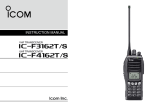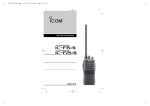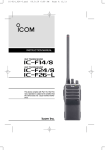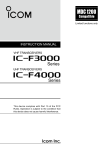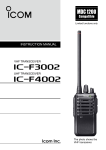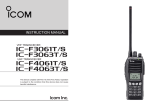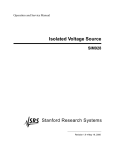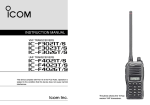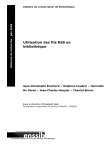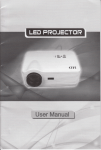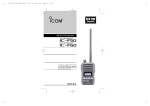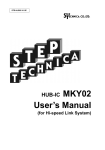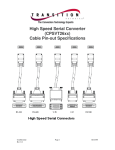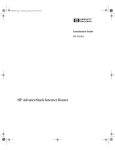Download icom IC-F3062/4062 S&T User Manual
Transcript
INSTRUCTION MANUAL VHF TRANSCEIVER iF3062T/S UHF TRANSCEIVER iF4062T/S This device complies with Part 15 of the FCC Rules. Operation is subject to the condition that this device does not cause harmful interference. IMPORTANT READ ALL INSTRUCTIONS carefully and completely before using the transceiver. SAVE THIS INSTRUCTION MANUAL — This instruction manual contains important operating instructions for the IC-F3062T/S VHF TRANSCEIVERS and IC-F4062T/S UHF TRANSCEIVERS. Icom, Icom Inc. and the logo are registered trademarks of Icom Incorporated (Japan) in the United States, the United Kingdom, Germany, France, Spain, Russia and/or other countries. i EXPLICIT DEFINITIONS WORD DEFINITION Personal injury, fire hazard or electric shock RWARNING may occur. CAUTION NOTE Equipment damage may occur. If disregarded, inconvenience only. No risk of personal injury, fire or electric shock. TABLE OF CONTENTS IMPORTANT ........................................................................ i EXPLICIT DEFINITIONS ..................................................... i TABLE OF CONTENTS ...................................................... ii PRECAUTIONS ................................................................. iii 1 ACCESSORIES ......................................................... 1–3 ■ Supplied accessories ................................................. 1 ■ Accessory attachments .............................................. 1 2 PANEL DESCRIPTION ........................................... 4–10 ■ Front panel ................................................................. 4 ■ Function display ......................................................... 6 ■ Programmable function keys ..................................... 7 3 BASIC OPERATION .............................................. 11–16 ■ Turning power ON .................................................... 11 ■ Channel selection .................................................... 12 ■ Call procedure .......................................................... 12 ■ Receiving and transmitting ....................................... 13 ■ User set mode .......................................................... 16 ■ Scrambler function ................................................... 16 4 BIIS OPERATION .................................................. 17–27 ■ Setting example ....................................................... 17 ■ Receiving a call ........................................................ 17 ■ Transmitting a call .................................................... 19 ■ Receiving a message ............................................... 21 ■ Transmitting a status ................................................ 23 ■ Transmitting an SDM (Short Data Message) ............ 24 ■ Position data transmission ....................................... 25 ■ Printer connection .................................................... 26 ■ Digital ANI ................................................................ 26 ■ Auto emergency transmission .................................. 26 ■ Stun function ............................................................ 26 ■ BIIS indication .......................................................... 27 ■ Priority A channel selection ...................................... 27 5 BATTERY CHARGING .......................................... 28–32 ■ Caution ..................................................................... 28 ■ Optional battery chargers ......................................... 30 1 2 3 4 5 6 7 8 9 6 BATTERY CASE ......................................................... 33 7 SWIVEL BELT CLIP .............................................. 34–35 ■ MB-93 contents ........................................................ 34 ■ Attaching .................................................................. 34 ■ Detaching ................................................................. 35 8 OPTIONS ............................................................... 36–38 9 DOC ....................................................................... 39–41 ii PRECAUTIONS R CAUTION! NEVER hold the transceiver so that the antenna is very close to, or touching exposed parts of the body, especially the face or eyes, while transmitting. The transceiver will perform best if the microphone is 5 to 10 cm away from the lips and the transceiver is vertical. R CAUTION! NEVER operate the transceiver with a headset or other audio accessories at high volume levels. R CAUTION! NEVER short the terminals of the battery pack. DO NOT push [PTT] when not actually desiring to transmit. AVOID using or placing the transceiver in direct sunlight or in areas with temperatures below –25°C or above +55°C. The basic operations, transmission and reception of the transceiver are guaranteed within the specified operating temperature range. However, the LCD display may not be operated correctly, or show an indication in the case of long hours of operation, or after being placed in extremely cold areas. iii DO NOT modify the transceiver for any reason. KEEP the transceiver from the heavy rain, and Never immerse it in the water. The transceiver construction is water resistant, not waterproof. The use of non-Icom battery packs/chargers may impair transceiver performance and invalidate the warranty. ACCESSORIES ■ Supplied accessories ■ Accessory attachments The following accessories are supplied: Qty. q Flexible antenna …………………………………………… 1 w Battery pack ……………………………………………… 1 e Belt clip …………………………………………………… 1 r Connector cover (with screw) ……………………… 1 set D Flexible antenna Some accessories are not supplied with depending on versions. q w 1 1 Connect the supplied flexible antenna to the antenna connector. CAUTION! • NEVER HOLD by the antenna when carrying the transceiver. • Transmitting without an antenna may damage the transceiver. e r 1 1 ACCESSORIES ï Battery pack D Belt clip To attach the battery pack: Slide the battery pack in the direction of the arrow (q), then lock it with the battery release button. To attach the belt clip: q Release the battery pack if it is attached. w Slide the belt clip in the direction of the arrow until the belt clip is locked and makes a ‘click’ sound. • Slide the battery pack until the battery release button makes a ‘click’ sound. To release the battery pack: Slide the battery release button in the direction of the arrow (w) as shown below. The battery pack is then released. NEVER release or attach the battery pack when the transceiver is wet or soiled. This may result water or dust getting into the transceiver/battery pack and may result in the transceiver being damaged. To detach the belt clip: q Release the battery pack if it is attached. w Pinch the clip (q), and slide the belt clip in the direction of the arrow (w). w Battery release button q w 2 q ACCESSORIES 1 ï Connector cover 1 Attach the connector cover when the optional speaker-microphone or head-set is not used. To attach the connector cover: q Insert the connector cover into the multi-connector. w Tighten the screw. To detach the connector cover: q Unscrew the screw using a phillips screwdriver. w Detach the connector cover for the speaker-microphone or head-set connector. Multiconnector q w Connector cover w q CAUTION! Attach the connector cover when the optional speakermicrophone is not used. Otherwise the terminals of the multi-connector may be shorted by metal object, etc., and this could damage the transceiver. 3 2 PANEL DESCRIPTION ■ Front panel q ROTARY SELECTOR Rotate to select the pre-programmed memory channels or the operating zone. (Depending on the pre-setting) q w e r t y u !2 w ANTENNA CONNECTOR Connects the supplied antenna. !1 !0 Speaker Microphone o i e DEALER-PROGRAMMABLE KEY [Emer] Desired functions can be programmed by your dealer. ((☞ p. 7)) r DEALER-PROGRAMMABLE KEY [Side1] Desired functions can be programmed by your dealer. ((☞ p. 7)) t PTT SWITCH [PTT] Push and hold to transmit; release to receive. y DEALER-PROGRAMMABLE KEYS [Side2]/[Side3] Desired functions can be programmed independently by your dealer. ((☞ p. 7)) u 10-KEYPAD (Depending on version) The keypad allows you to enter digits to: • Select memory channels • Select tone channels • Select DTMF codes (during transmit) • Set TX codes • Set BIIS status number • Input text message for SDM operation. • Start up with the password 4 PANEL DESCRIPTION i DEALER-PROGRAMMABLE KEYS [P0] to [P3] Desired functions can be programmed independently by your dealer. ((☞ p. 7)) o FUNCTION DISPLAY Displays a variety of information such as an operating channel number/name, 2/5-tone code, DTMF numbers, selected function, etc. 2 !1 BUSY/TRANSMIT INDICATOR ➥ Lights green while receiving a signal, or when the squelch is open. ➥ Lights red while transmitting. 2 !2 VOLUME CONTROL [VOL] Rotate to turn the power ON/OFF and adjusts the audio level. !0 MULTI-CONNECTOR Connect an optional speaker-microphone. Connector cover NOTE: Attach the connector cover when the optional speaker-microphone is not used. See ((☞ p. 3)) for details. 5 2 PANEL DESCRIPTION ■ Function display r COMPANDER INDICATOR Appears when the compander function is activated. q we r tyu i t SCRAMBLER INDICATOR Appears when the voice scrambler function is activated. o CALA TXCU TXC SET !0 q SIGNAL STRENGTH INDICATOR Indicates relative signal strength level. w LOW POWER INDICATOR Appears when low output power is selected. e AUDIBLE INDICATOR ➥ Appears when the channel is in the ‘audible’ (unmute) condition. ➥ Appears when the specified 2/5-tone/BIIS code is received. 6 y BELL INDICATOR Appears/blinks when the specific 2/5-tone/BIIS code is received, according to the pre-programming. u CALL CODE MEMORY INDICATOR Appears when the call code memory is selected. i BATTERY INDICATOR Appears or blinks when the battery power decreases to a specified level. o ALPHANUMERIC DISPLAY ➥ Displays an operating channel number, channel name, Set mode contents, DTMF code, etc. ➥ The indication mode can be selected from 1 line or 2 lines. Ask your dealer for details. • In this instruction manual, the LCD illustration is described using the 2 lines indication mode. !0 KEY INDICATOR Indicate the programmed function of the front panel keys ([P0], [P1], [P2] and [P3]). PANEL DESCRIPTION 2 ■ Programmable function keys The following functions can be assigned to [Emer], [Side1], [Side2], [Side3], [P0], [P1], [P2] and [P3] programmable function keys. Consult your Icom dealer or system operator for details concerning your transceivers programming. If the programmable function names are bracketed in the following explanations, the specific key is used to activate the function depends on the programming. UP” “D DOWN” CH UP AND DOWN KEYS “U ➥ Push to select an operating channel. ➥ Push to select a transmit code channel after pushing [TX Code CH Select]. ➥ Push to select a DTMF channel after pushing [DTMF Autodial]. ➥ Push to select a scan group after pushing and holding [Scan A Start/Stop]/[Scan B Start/Stop]. ➥ Push to select a BIIS code, status number or SDM after pushing [Digital Button]. ZONE” ZONE KEY “Z Push this key, then push [CH Up] or [CH Down] to select the desired zone. What is “zone”?— The desired channels are assigned into a zone according to the intended use for grouping. For example, ‘Staff A’ and ‘Staff B’ are assigned into a “Business” zone, and ‘John’ and ‘Cindy’ are assigned into a “Private” zone. 2 SCNA” SCAN A KEY “S ➥ This key’s operation depends on the Power ON Scan setting. When the power ON scan function is turned OFF; Push to start and cancel scanning operation. In case of transmission during scan, cancels scanning. When the power ON scan function is turned ON; Push to pause scanning., then resumes scanning after passing a specified time period. In case of transmission during scan, scanning will be cancelled. ➥ Push and hold this key for 1 sec. to indicate the scan group, then push [CH Up] or [CH Down] to select the desired group. SCNB” SCAN B KEY “S ➥ Push to start and cancel scanning operation. In case of transmission during scan, pauses scanning. Scanning resumes after passing a specified time period. ➥ Push and hold this key for 1 sec. to indicate the scan group, then push [CH Up] or [CH Down] to select the desired group. 7 2 PANEL DESCRIPTION SCAD” SCAN ADD/DEL (TAG) KEY “S Push to add or delete the selected channel to/from the scan group. PRA” “P PRAR” “P PRB” “P PRBR” PRIO A/B KEYS “P ➥ Push to select Priority A or Priority B channel. ➥ Push and hold [Prio A (Rewrite)] to rewrite the Prio A channel. CH1” “C CH2” “C CH3” “C CH4” MR-CH 1/2/3/4 KEYS “C Push to select an operating channel directly. LOCK” LOCK KEY “L ➥ Push and hold for 1 sec. to electronically lock all programmable keys except the following: [Call] (incl. Call A and Call B), [Moni(Audi)] and [Emergency]. ➥ Push and hold for 1 sec. again to turn the lock function OFF. H/L” HIGH/LOW KEY “H Push to select the transmit output power temporarily or permanently, depending on the pre-setting. • Ask your dealer for the output power level for each selection. MON” MONI (AUDI) KEY “M ➥ Activates one of (or two of) the following functions on each channel independently: (PMR or BIIS PMR operation only) • Push and hold to un-mute the channel (audio is emitted; ‘Audible’ condition). • Push to mute the channel (sets to ‘Inaudible’ only). • Push to un-mute the channel (sets to ‘Audible’ only). • Push after the communication is finished to send a ‘reset code.’ NOTE: The un-mute condition (‘Audible’ condition) may automatically return to the mute condition (‘Inaudible‘ condition) after a specified period depending on programming. LIGT” LIGHT KEY “L Push to turn the transceiver’s backlight ON temporarily only when the backlight function is turned OFF in user set mode. 8 TSEL” C.TONE CH ENT KEY “T Push to select the continuous tone channel using [CH Up]/[CH Down] to change the tone frequency/code setting. The selected channel remains set as the continuous tone channel until another channel is designated as such. TA” TALK AROUND KEY “T Push to turn the talk around function ON and OFF. • The talk around function equalizes the transmit frequency to the receive frequency for transceiver-to-transceiver communication. W/N” WIDE/NARROW KEY “W Push to toggle the IF bandwidth between wide and narrow. • The wide passband width can be selected from 25.0 or 20.0 kHz using the CS-F3060 CLONING SOFTWARE. (PMR or BIIS PMR operation only) Ask your Dealer for details. PANEL DESCRIPTION DTMA” DTMF AUTODIAL KEY “D ➥ Push to enter the DTMF channel selection mode. Then select the desired DTMF channel using [CH Up]/[CH Down]. ➥ After selecting the desired DTMF channel, push this key to transmit the DTMF code. DTMR” RE-DIAL KEY “D Push to transmit the last-transmitted DTMF code. CALL” “C CALA” “C CALB” CALL KEYS “C Push to transmit a 2/5-tone/BIIS ID code. • Call transmission is necessary before you call another station depending on your signaling system. • [Call A] and/or [Call B] may be available when your system employs selective ‘Individual/Group’ calls. Ask your dealer which call is assigned to each key. EMR” EMERGENCY KEY “E ➥ Push and hold for a specified period to transmit an emergency call. ➥ When [Emergency Single (Silent)] or [Emergency Repeat (Silent)] is pushed, an emergency call is transmitted without a beep emission and LCD indication change.* • If you want to cancel the emergency call, push (or push and hold) the key again before transmitting the call. • The emergency call is transmitted one time only or repeatedly until receiving a control code depending on the pre-setting. *BIIS PMR operation only 2 SURV” SURVEILLANCE KEY “S Push to turn the surveillance function ON or OFF. When this function is turned ON, the beep is not emitted and the LCD backlight does not light when a signal is received or a key is pushed, etc. 2 TXCE” TX CODE ENTER KEY “T (PMR or BIIS PMR operation only) Push to enter the ID code edit mode directly, for both 5-tone and BIIS. Then set the desired digit using [CH Up]/ [CH Down] or 10-keypad*. ((☞ p. 14)) *IC-F3062T/IC-F4062T (10-key type) only TXC” TX CODE CHANNEL SELECT KEY “T ➥ Push to enter the ID code channel selection mode directly. Then set the desired channel using [CH Up]/[CH Down]. ((☞ p. 14)) ➥ During ID code channel selection mode, push for 1 sec. to enter the ID code edit mode for 5-tone and BIIS. Then set the desired digit using [CH Up]/[CH Down] or 10-keypad*. ((☞ p. 14)) *IC-F3062T/IC-F4062T (10-key type) only TXCU” “T TXCD” TX CODE CHANNEL UP/DOWN KEYS “T Push to select a TX code channel directly. 9 2 PANEL DESCRIPTION IDMS” ID-MR SELECT KEY “I (PMR or BIIS PMR operation only) ➥ Recalls detected ID codes. • Push this key, then select the ID code using [CH Up]/[CH Down]. • Up to 5 ID’s are memorized. ➥ Push and hold to erase the selected ID’s. SCR” SCRAMBLER FUNCTION “S Push to toggle the voice scrambler function ON and OFF. COMP” COMPANDER KEY “C Push to toggle the compander function ON and OFF. The compander function reduces noise components from the transmitting audio to provide clear communication. SET” USER SET MODE KEY “S ➥ Push and hold to enter user set mode. • During user set mode, push this key to select an item, and change the value or condition using push [CH Up]/[CH Down]. ➥ Push and hold this key again to exit user set mode. User set mode is also available via the ‘Power ON function.’ Refer to ((☞ p. 16)) also. OP1” “O OP2” “O OP3” OPT OUT KEYS “O Push to control the output signal level of the optional ports in the optional unit connector. 10 O1M” “O O2M” “O O3M” OPT MOMENTARY KEYS “O Push and hold to control the output signal level of the optional ports in the optional unit connector. BIFN” DIGITAL BUTTON KEY “B (BIIS operation only) ➥ Push to select the call ID list, transmit message and standby condition. Toggles between queue channel and received message record indication after queue channel is selected. ➥ Push and hold to select queue channel indication. BIUP” “B BIDN” STATUS UP/DOWN KEYS “B (BIIS operation only) ➥ While in the standby condition, push to display the transmit status indication and select a status number. ➥ When a received SDM is displayed, push to cancel the automatic scroll and scroll the message manually. ➥ When an SDM that contains more than 12 characters is displayed, push to scroll the message manually. BASIC OPERATION 3 ■ Turning power ON Prior to using the transceiver for the first time, the battery pack must be fully charged for optimum life and operation. ((☞p. 30)) q Rotate [VOL] to turn the power ON. w If the transceiver is programmed for a start up password, input the digit codes as directed by your dealer. • 10-keypad can be used for password input depending on version: • The keys in the table below can be used for password input: • The transceiver detects numbers in the same block as identical. Therefore “01234” and “56789” are the same. (Side3) KEY NUMBER 0 1 2 3 4 5 6 7 8 9 D Battery type selection The battery type must be selected according to the attaching battery type when tuning the transceiver ON. 2 3 ➥ While pushing and holding [Emer] and [PTT], rotate [VOL] to toggle the attaching battery type. • After the display appears, release [Emer] and [PTT]. • “DRY BATT” is displayed for about 3 sec. then “Lo” appears when the battery case operation is selected. • “LI-ION” is displayed for about 3 sec. when the Lithium-ion battery operation is selected. • This operation may not be available depending on the pre-setting. Ask your dealer for details. e When the “PASSWORD” indication does not clear after inputting 4 digits, the input code number may be incorrect. Turn the power off and start over in this case. 11 3 BASIC OPERATION ■ Channel selection ■ Call procedure Several types of channel selections are available. Methods may differ according to your system set up. When your system employs tone signaling (excluding CTCSS and DTCS), the call procedure may be necessary prior to voice transmission. The tone signaling employed may be a selective calling system which allows you to call specific station(s) only and prevent unwanted stations from contacting you. NON-ZONE TYPE: Push [CH Up] or [CH Down], or rotate [ROTARY SELECTOR]* to select the desired operating channel, in sequence; or, push one of [MR-CH 1] to [MR-CH 4] keys to select a channel directly. • Up to 16 pre-programmed channels can be selected via [ROTARY SELECTOR].* ZONE TYPE: Push [Zone], then push [CH Up] or [CH Down] or rotate [ROTARY SELECTOR]* to select the desired zone. AUTOMATIC SCAN TYPE: Channel setting is not necessary for this type. When turning power ON, the transceiver automatically starts scanning. Scanning stops when receiving a call. *Depending on the pre-setting. 12 q Select the desired TX code channel or 2/5-tone code according to your System Operator’s instructions. • This may not be necessary depending on programming. • Refer to ((☞ pages. 14 or 15)) for selection. w Push the call key (assigned to one of the dealer programmable keys: [Emer], [Side1], [Side2], [Side3], [P0], [P1], [P2] and [P3]) or [PTT]. e After transmitting a 2/5-tone code, the remainder of your communication can be carried out in the normal fashion. Selective calling Non-selective calling BASIC OPERATION 3 ■ Receiving and transmitting NOTE: Transmitting without an antenna may damage the transceiver. See ((☞ p. 1)) for accessory attachments. Receiving: q Rotate [VOL] to turn the power ON. w Push [CH Up] or [CH Down], or rotate [ROTARY SELECTOR]* to select the conventional system channel, in sequence. *Depending on the pre-setting. e When receiving a call, adjust the audio output level to a comfortable listening level. Transmitting: Wait for the channel to become clear to avoid interference. q Push [Call] when initiating a call from your side. • Coded audio may be heard from the transceiver, then “ ” appears. • This operation may not be necessary depending on your signaling system. Ask your dealer for details. D Transmitting notes • Transmit inhibit function The transceiver has several inhibit functions which restrict transmission under the following conditions: - The channel is in mute condition (‘Inaudible’ condition; “ ” does not appear.) - The channel is busy. - Un-matched (or matched) CTCSS is received. 3 (Depending on the pre-setting.) - The selected channel is a ‘receive only’ channel. • Time-out timer After continuous transmission for the pre-programmed time period, the time-out timer is activated, causing the transceiver to stop transmitting. • Penalty timer Once the time-out timer is activated, transmission is further inhibited for a period determined by the penalty timer. w While pushing and holding [PTT], speak into the microphone at a normal voice level. e Release [PTT] to return to receive. IMPORTANT: To maximize the readability of your signal; 1. Pause briefly after pushing [PTT]. 2. Hold the microphone 5 to 10 cm (2 to 4 inches) from your mouth, then speak into the microphone at a normal voice level. 13 3 BASIC OPERATION D TX code channel selection D TX code number edit If the transceiver has [TX Code CH Select] assigned to it, the indication can be toggled between the operating channel number (or name) and TX code channel number (or name). When the TX code channel number (or name) is displayed, [CH Up] or [CH Down] selects the TX code channel. (PMR or BIIS PMR operation only) If the transceiver has [TX Code CH Select] or [TX Code Enter] assigned to it, TX code contents can be edited within the allowable digits. USING [TX CODE CH SELECT] KEY: q Push [TX Code CH Select]— a TX code channel number (or name) appears. w Push [CH Up] or [CH Down] to select the desired TX code channel. e Push [Call] (or [PTT] during MSK operation) to transmit the selected TX code. r Push [TX Code CH Select] again to return to the operating channel number indication. USING [TX CODE CH UP]/[TX CODE CH DOWN] KEY: If the transceiver has a [TX Code CH Up] or [TX Code CH Down] key assignment, the programmed TX code channel can be selected directly when pushed. NOTE for PMR or BIIS PMR operation: • The LCD indication does not change when the operating channel number (or name) is displayed. (Depending on the pre-setting) • To check the selected TX code, push [TX Code CH Select]. 14 USING [TX CODE CH SELECT] KEY: q Push [TX Code CH Select] to enter the TX code channel selection mode. • Select the desired channel before entering the TX code channel selection mode if necessary. w Push and hold [TX Code CH Select] for 1 sec. to enter the TX code edit mode. e Push [TX Code CH Select] to select the desired digit to be edited. • The digit to be edited blinks. r Push [CH Up], [CH Down] or 10-keypad* to set the desired digit. t Push [TX Code CH Select] to set the digit. The digit to the right will blink automatically. • When the 10-keypad* is used for setting, the digit to the right will blink automatically without pushing [TX Code CH Select]. y Repeat r and t to input all allowable digits. u Push [Call] or [PTT] to transmit the edited TX code. *IC-F3062T/IC-F4062T (10-key type) only BASIC OPERATION USING [TX CODE ENTER] KEY: q Select the desired TX code channel via [TX Code CH Select]+[CH Up] or [CH Down], [TX Code CH Up] or [TX Code CH Down]. w Push [TX Code Enter] to enter the TX code edit mode. e Push [TX Code Enter] to select the desired digit to be edited. • The digit to be edited blinks. r Push [CH Up], [CH Down] or 10-keypad* to set the desired digit. t Push [TX Code Enter] to set the digit. The digit to the right will blink automatically. 3 D DTMF transmission If the transceiver has [DTMF Autodial] assigned to it, the automatic DTMF transmission function is available. Up to 8 DTMF channels are available. 3 TO SELECT A TX CODE: q Push [DTMF Autodial]— a DTMF channel appears. w Push [CH Up] or [CH Down] to select the desired DTMF channel. e Push [DTMF Autodial] to transmit the DTMF code in the selected DTMF channel. • When the 10-keypad* is used for setting, the digit to the right will blink automatically without pushing [TX Code CH Enter]. y Repeat r and t to input all allowable digits. u Push [Call] or [PTT] to transmit the edited TX code. *IC-F3062T/IC-F4062T (10-key type) only 15 3 BASIC OPERATION ■ User set mode ■ Scrambler function User set mode is accessed at power ON and allows you to set seldom-changed settings. In this case you can “customize” the transceiver operation to suit your preferences and operating style. The voice scrambler function provides private communication between stations. The frequency inversion type is equipped to all versions, moreover, the optional Rolling or Non-rolling type can be available. Entering the user set mode: q While pushing and holding [P1] and [P2], rotate [VOL] to turn the power ON. Then, push and hold [P0] to enter user set mode. w Push [P0] several times to select the appropriate item. Then push [Side2] or [Side3] to set the desired level/condition. • Available set mode functions are Backlight, LCD contrast, Beep, Beep Level, Ringer Level, SQL Level, AF Min Level, Mic Gain, VOX Gain, VOX Delay, Battery Voltage and Signal Moni. e Rotate [VOL] to turn the power OFF to exit user set mode. NOTE: User set mode is also available via a programmable key. Please refer to ((☞ p. 10)) [User Set Mode] section. 16 q Push [Scrambler] to turn the scrambler function ON. • “ ” appears. w Push [Scrambler] again to turn the scrambler function OFF. • “ ” disappears. BIIS OPERATION ■ Setting example ■ Receiving a call The following functions are assigned to each programmable key for display example. However, the assigned function can be changed by your dealer. Ask your dealer for details. q When an individual call is received; [P0]; Call : Push to transmit a 5-tone/BIIS call when the selected channel is a 5-tone or BIIS channel. [P1]; Digital Button : Push to select the call list ID/transmit message, or to display the receive message record for selection. CALL” is displayed on the key indicator. • “C BIFN” is displayed on the key indicator. • “B BIFN ” is When this key is pushed, “B inverted as “ .” [P2]; Null : No function is assigned. [P3]; TX Code Enter : Push to enter the ID code edit mode directly for both 5-tone and BIIS. TXCE” is displayed on the key indicator. • “T [Emer]; Null [Side1]; Moni(Audi) : No function is assigned. : Push this key after the communication to send a ‘Clear down’ signal during BIIS channel operation. [Side2]/[Side3]; CH Up/Down : While in the standby condition, selects the operating channel. After pushing [Digital Button] or [TX Code CH Select], selects call list or TX code channel, respectively. 4 D Individual call • Beeps sound. • “ ” appears and the mute is released. CALLING”) and the calling • The programmed text message (e.g.“C station ID (or text) is displayed when the indication mode is 2 lines. CALLING”) and the calling • The programmed text message (e.g.“C station ID (or text) is displayed alternately when the indication mode is 1 line, depending on the setting. • “ ” appears or blinks depending on the setting. Appears 3 4 Appears or blinks CALLING 0500 CALL BIFN TXC TXCE w Push and hold [PTT], then speak into the microphone at a normal voice level. • TX indicator lights red. e Release [PTT] to return to receive. • BUSY indicator lights green while receiving a signal. r To finish the conversation, push [Moni(Audi)] to send the ‘Clear down’ signal. • Either station can send a ‘Clear down’ signal. CLR DOWN” is displayed for 2 sec. (approx.). • “C • “ ” disappears and the transceiver returns to the standby condition. 17 4 BIIS OPERATION D Group call D Displaying the received call record — Queue indication q When a group call is received; • Beeps sound. • “ ” appears and the mute is released. GROUP”) and the calling sta• The programmed text message (e.g.“G tion ID (or text) is displayed when the indication mode is 2 lines. GROUP”) and the calling • The programmed text message (e.g.“G station ID (or text) is displayed alternately when the indication mode is 1 line, depending on the setting. • “ ” appears or blinks depending on the setting. Appears Appears or blinks GROUP 1120 CALL BIFN TXC TXCE w Push and hold [PTT], then speak into the microphone at a normal voice level. • TX indicator lights red. NOTE: Only one station is permitted to speak. e Release [PTT] to return to receive. • BUSY indicator lights green while receiving a signal. r To finish the conversation, push [Moni(Audi)] to send the ‘Clear down’ signal. • Either station can send a ‘Clear down’ signal. CLR DOWN” is displayed for 2 sec. (approx.) • “C • “ ” disappears and the transceiver returns to the standby condition. 18 The transceiver memorizes the calling station ID in the memory. Up to 3 calls can be memorized, and the oldest call record is erased when a 4th call is received. However, once the transceiver is powered OFF, the all records are cleared. q Push and hold [Digital Button] for 1 sec. • Displays following indication. When a record is available <QUEUE> –QUEUE!– CALL BIFN TXC TXCE When no record is available <QUEUE> NO QUEUE CALL BIFN TXC TXCE w Push [CH Up] or [CH Down] to select the desired call. e Push and hold [Digital Button] for 1 sec. again to return to the standby condition. • When no operation is performed for 30 sec., the transceiver returns to the standby condition automatically. BIIS OPERATION 4 ■ Transmitting a call A total of 3 ways for code selection are available—selecting the call code from memory, entering the call code from the keypad and calling back from the queue channel record. D Using call memory q While in the standby condition, push [Digital Button] to enter the call code memory channel selection mode. •“ ” appears. Appears D Calling back from the queue channel q While in the standby condition, push and hold [Digital Button] for 1 sec. to enter the queue memory channel selection mode. w Push [CH Up] or [CH Down] to select the desired record. 4 <QUEUE> –QUEUE!– CALL BIFN TXC TXCE CALLING 0500 CALL BIFN TXC TXCE w Push [CH Up] or [CH Down] to select the desired call code. e Push [Call] or [PTT]* to call. *PTT call can be made only when PTT call capability is permitted. NOTE: When no answer back is received, the transceiver repeats the call 3 times (default) automatically, WAIT” is displayed during each call. However, an and “W FAILED” is displayed when no error beep sounds and “F answer back is received after the calls. e Push [Call] or [PTT]* to call. *PTT call can be made only when PTT call capability is permitted. NOTE: When no answer back is received, the transceiver repeats the call 3 times (default) automatically, WAIT” is displayed during each call. However, an and “W FAILED” is displayed when no error beep sounds and “F answer back is received after the calls. r Push [PTT] to transmit; release to receive. t Push [Moni(Audi)] to send the ‘Clear down’ signal. r Push [PTT] to transmit; release to receive. t Push [Moni(Audi)] to send the ‘Clear down’ signal. 19 4 BIIS OPERATION D Direct code entry q While in the standby condition, push [TX Code Enter] to enter the TX code edit mode. u Push [PTT] to transmit; release to receive. i Push [Moni(Audi)] to send the ‘Clear down’ signal. • Code digit for editing blinks. For your information When the “UpDate” setting for the call code is enabled, the set code is overwritten into the call code memory. 0500 CALL BIFN TXC TXCE w Push [TX Code Enter] to select the desired digit to be edited. • Digit for editing differs according to the setting. e Set the desired digit using [CH Up]/[CH Down] or 10-keypad*. *IC-F3062T/IC-F4062T (10-key type) only r Push [TX Code Enter] to set the digit, then the digit to the right will blink automatically. • When the 10-keypad is used for setting, the digit to the right will blink automatically without pushing [TX Code Enter]. t Repeat e and r to input all allowable digits. y Push [Call] or [PTT]* to call. *PTT call can be made only when PTT call capability is permitted. NOTE: When no answer back is received, the transceiver repeats the call 3 times (default) automatically, and “WAIT” is displayed during each call. However, an FAILED” is displayed when no error beep sounds and “F answer back is received after the calls. 20 BIIS OPERATION 4 ■ Receiving a message D Receiving a status message D Receiving an SDM (Short Data Message) q When a status message is received; q When an SDM is received; • Beeps sound. • The calling station ID (or text) and the status message is displayed alternately when the indication mode is 1 line, depending on the setting. RX Status 01 BASE CALL BIFN TXC TXCE w Push [Moni(Audi)] to return to the standby condition. NOTE: Only the calling station ID (or text) is displayed (no message is displayed alternately) when the scroll timer is set to ‘OFF.’ In this case, push [Status Up]/ [Status Down] to display the status message manually. • Beeps sound. • The calling station ID (or text) and the SDM is displayed alternately when the indication mode is 1 line, depending on the setting. 4 Thank you! BASE CALL BIFN TXC TXCE w When the received SDM includes more than 12 characters, the message scrolls automatically, when the automatic scroll function is activated. • Push [Status Up]/[Status Down] to scroll the message manually. How about you? Scrolls BASE CALL BIFN TXC TXCE e Push [Moni(Audi)] to return to the standby condition. X 21 4 BIIS OPERATION D Received message selection The transceiver memorizes the received message in the memory. Up to 6 messages for status and SDM, or 95 character SDM’s can be memorized. The oldest message is erased when the 7th message is received. However, once the transceiver is powered OFF, all messages are cleared. e Push [CH Up] or [CH Down] to select the desired message. q Push and hold [Digital Button] for 1 sec. r Push and hold [Digital Button] for 1 sec. again to return to the standby condition. • Displays queue memory. w Push [Digital Button] momentarily. • Displays message memory. When a message is available MESSAGE – MSG! – CALL BIFN TXC TXCE When no message is available MESSAGE –NO MSG– CALL BIFN TXC TXCE 22 • When selecting the SDM that includes more than 12 characters, the message scrolls automatically when the automatic scroll function is activated. • Push [Status Up]/[Status Down] to scroll the message manually. • When no operation is performed for 30 sec., the transceiver returns to the standby condition automatically. BIIS OPERATION 4 ■ Transmitting a status D General D Transmitting a status The status message can be selected with the programmed text, and the message text is also displayed on the function display of the called station. Up to 24 status types (1 to 24) are available, and the status messages 22 and 24 have designated meanings. Status 22: Emergency* Status 24: GPS request q While in the standby condition, push [Digital Button], then push [CH Up] or [CH Down] to select the desired station/group code. w Push [Digital Button] again, then push [CH Up] or [CH Down] to select the desired status message. *The status 22 can also be used as a normal status message by disabling the designated meaning. However, the status 24 is fixed. The status call can be sent with both individual and group calls. 4 Or, you can select the desired status message using [Status Up]/[Status Down] key directly. STATUS 01 TX Status 01 CALL BIFN TXC TXCE Status message is displayed. e Push [Call] or [PTT]* to transmit the status message to the selected station/group. *PTT call can be made only when PTT call capability is permitted. • 2 beeps will sound and the transceiver returns to the standby condition automatically when the transmission is successful. 23 4 BIIS OPERATION ■ Transmitting an SDM (Short Data Message) D Programming an SDM memory D General The short data message, SDM, can be sent to an individual station or group stations. Also, 8 SDM memory channels are available and the messages can be edited via PC programming. D Transmitting an SDM q While in the standby condition, push [Digital Button], then push [CH Up] or [CH Down] or rotate [ROTARY SELECTOR] to select the desired station/group code. w Push [Digital Button] again, then push [CH Up] or [CH Down] to select the desired SDM. Or, you can select the desired SDM using [Status Up]/ [Status Down] key directly. MESSAGE 1 How are you? CALL BIFN TXC TXCE SDM is displayed. e Push [Call] or [PTT]* to transmit the SDM to the selected station/group. *PTT call can be made only when PTT call capability is permitted. • 2 beeps will sound and the transceiver returns to the standby condition automatically when the transmission is successful. 24 (IC-F3062T/IC-F4062T (10-key type) only) q During standby condition, push [Digital Button] twice, then push [CH Up] or [CH Down] to select the desired SDM to be edited. w Push [M] or [#] to enter the message editing condition. • The first character blinks when [#] is pushed, the last character blinks when [M] is pushed. Blinks MESSAGE 1 How are you? CALL BIFN TXC TXCE When [#] is pushed. e Push the appropriate digit key, [0] to [9], to enter the desired character. • See the table at right for the available characters. • Pushing [CH Up] also enters space, pushing [CH Down] deletes the selected character. r Push [#] to move the cursor to the right, push [M] to move the cursor to the left. t Repeat steps e and r to set the desired text message. y Push and hold [Digital Button] for 1 sec. to overwrite the set content into the memory. • Push [Digital Button] momentarily to cancel the editing and return to the original message indication. BIIS OPERATION 4 ■ Position data transmission • Available characters Key Characters [0] 0 | ! ? ’ ” , ; : _ ( ) < > [ ] [1] [3] 1 (space) # ∗ / + – = \ & % $ @ ^ 2 ABC a b c 3DEF d e f [4] 4GH I g h i [5] [6] 5 J K L j k l 6 MNOm n o [7] 7 PQRS p q r s [8] 8 TUV t u v 9WX Y Z w x y z [2] [9] NOTE: A decimal point can only be written with the CSF3060 CLONING SOFTWARE. Pre-programmed characters can be rewritten with the 10-keypad, except for the decimal point, as it is not included in the transceiver character list, and cannot be displayed again. When the optional cable (OPC-966) and a GPS receiver is connected to the transceiver, the position (longitude and latitude) data can be transmitted automatically. Ask your dealer or system operator for connection details. 4 The position data is transmitted when; • Status 24 message is received *When the status 24 message, GPS request, is received. • Fully automatic When automatic position transmission is enabled, send the position data according to ‘Time Marker’ and ‘Interval Timer’ settings. • PTT is released When ‘Send with Logoff’ is enabled. - Set the ‘Log-In/Off’ item as ‘L-OFF.’ • After sending a status message When ‘Send with Status’ is enabled. • After sending an SDM When ‘Send with SDM’ is enabled. • After sending status 22 (Emergency) When ‘Send with Emergency’ is enabled. 25 4 BIIS OPERATION ■ Printer connection ■ Auto emergency transmission When the optional cable is connected to the transceiver, a printer can be connected to print out the received SDM content and the ID of the station who sent the message. Ask your dealer or system operator for connection details. When [Emergency Single (Silent)] or [Emergency Repeat (Silent)] is pushed, an emergency signal is automatically transmitted for the specified time period. ■ Digital ANI The own ID can be transmitted each time the PTT is pushed (log-in) or released (log-off) during individual or group call communications. By receiving the ANI, the communication log can be recorded when using a PC dispatch application. In addition, when using the ANI with log-in, the PTT side tone function can be used to inform you that the ID is sent and voice communication can be performed. The status 22 (Emergency) is sent to the selected ID station, and the position data is transmitted after the emergency signal when a GPS receiver is connected to the transceiver. The emergency transmission is performed on the emergency channel, however, when no emergency channel is specified, the signal is transmitted on the previously selected channel. There is no change in the function display or beep emission during automatic emergency transmission. ■ Stun function When the specified ID, set as a killer ID, is received, the stun function is activated. When the killer ID is received, the transceiver switches to the password required condition. Entering of the password via the keypad is necessary to operate the transceiver again in this case. 26 BIIS OPERATION 4 ■ BIIS indication The following indications are available for the BIIS operation on a BIIS channel. CONNECT : Individual/group call is successful. OK : Message (status or SDM) transmission is successful. FAILED : No answer back is received. WAIT : Appears during retry of the call (2nd call). CLR DOWN : End the communication. BUSY : Operating channel is in the busy condition. 4 ■ Priority A channel selection When one of the following operations is performed, the transceiver selects the Priority A channel automatically. Priority A is selected when; • Clear down signal is received/transmitted - Set the ‘Move to PrioA CH’ item as ‘Clear down.’ • Turning the power ON The Priority A channel is selected each time the transceiver power is turned ON. • Status call The Priority A channel is selected when transmitting a status call. - Enable the ‘Send Status on PrioA CH’ item in the BIIS configuration. 27 5 BATTERY CHARGING ■ Caution Misuse of LITHIUM-ION batteries may result in the following hazards: smoke, fire, or the battery may rupture. Misuse can also cause damage to the battery or degradation of battery performance. • R DANGER! Use and charge only specified Icom battery packs with Icom radios or Icom charger. Only Icom battery packs are tested and approved for use and charge with Icom radios or Icom charger. Using third-party or counterfeit battery packs or charger may cause smoke, fire, or cause the battery to burst. D Battery caution • R DANGER! DO NOT hammer or otherwise impact the battery. Do not use the battery if it has been severely impacted or dropped, or if the battery has been subjected to heavy pressure. Battery damage may not be visible on the outside of the case. Even if the surface of the battery does not show cracks or any other damage, the cells inside the battery may rupture or catch fire. • R DANGER! NEVER use or leave battery packs in areas with temperatures above +60˚C. High temperature buildup in the battery, such as could occur near fires or stoves, inside a sun heated car, or in direct sunlight may cause the battery to rupture or catch fire. Excessive temperatures may also degrade battery performance or shorten battery life. 28 • R DANGER! DO NOT expose the battery to rain, snow, seawater, or any other liquids. Do not charge or use a wet battery. If the battery gets wet, be sure to wipe it dry before using. The battery is not waterproof. • R DANGER! NEVER incinerate used battery packs since internal battery gas may cause them to rupture, or may cause an explosion. • R DANGER! NEVER solder the battery terminals or NEVER modify the battery pack. This may cause heat generation, and the battery may rupture, emit smoke or catch fire. • R DANGER! Use the battery only with the transceiver for which it is specified. Never use a battery with any other equipment, or for any purpose that is not specified in this instruction manual. • R DANGER! If fluid from inside the battery gets in your eyes, blindness can result. Rinse your eyes with clean water, without rubbing them, and see a doctor immediately. • WARNING! Immediately stop using the battery if it emits an abnormal odor, heats up, or is discolored or deformed. If any of these conditions occur, contact your Icom dealer or distributor. • WARNING! Immediately wash, using clean water, any part of the body that comes into contact with fluid from inside the battery. BATTERY CHARGING • WARNING! NEVER put the battery in a microwave oven, high-pressure container, or in an induction heating cooker. This could cause a fire, overheating, or cause the battery to rupture. • CAUTION! Always use the battery within the specified temperature range for the transceiver (–25˚C to +55˚C) and the battery itself (–20˚C to +60˚C). Using the battery out of its specified temperature range will reduce the battery’s performance and battery life. Please note that the specified temperature range of the battery may exceed that of the transceiver. In such cases, the transceiver may not work properly because it is out of its operating temperature range. • CAUTION! Shorter battery life could occur if the battery is left fully charged, completely discharged, or in an excessive temperature environment (above +45˚C) for an extended period of time. If the battery must be left unused for a long time, it must be detached from the radio after discharging. You may use the battery until the battery indicator shows half-capacity, then keep it safely in a cool dry place with the temperature between –20˚C to +25˚C. 5 D Charging caution • R DANGER! NEVER charge the battery pack in areas with extremely high temperatures, such as near fires or stoves, inside a sun heated car, or in direct sunlight. In such environments, the safety/protection circuit in the battery will activate, causing the battery to stop charging. 5 • WARNING! DO NOT charge or leave the battery in the battery charger beyond the specified time for charging. If the battery is not completely charged by the specified time, stop charging and remove the battery from the battery charger. Continuing to charge the battery beyond the specified time limit may cause a fire, overheating, or the battery may rupture. • WARNING! NEVER insert the transceiver (battery attached to the transceiver) into the charger if it is wet or soiled. This could corrode the battery charger terminals or damage the charger. The charger is not waterproof. • CAUTION! DO NOT charge the battery outside of the specified temperature range: BC-160 (0˚C to +45˚C). Icom recommends charging the battery at +20˚C. The battery may heat up or rupture if charged out of the specified temperature range. Additionally, battery performance or battery life may be reduced. 29 5 BATTERY CHARGING ■ Optional battery chargers ï Rapid charging with the BC-160 ï AD-106 installation The optional BC-160 provides rapid charging of optional LiIon battery packs. • An AC adapter (may be supplied with BC-160 depending on version) or the DC power cable (OPC-515L/CP-17L) is additionally required. q Install the AD-106 desktop charger adapter into the holder space of the BC-119N/BC-121N. w Connect the plugs of the BC-119N/BC-121N to the AD-106 desktop charger adapter with the connector, then install the adapter into the charger with the supplied screws. AC adapter (Not supplied with some versions.) Battery pack Transceiver q AD-106 Connectors w Optional OPC-515L (for 13.8 V power source) or CP-17L (for 12 V cigarette lighter socket) can be used instead of the AC adapter. 30 Screws supplied with the charger adapter Plugs BATTERY CHARGING 5 ï Rapid charging with the BC-119N+AD-106 ï Rapid charging with the BC-121N+AD-106 The optional BC-119N provides rapid charging of battery packs. The following items are additionally required. • AD-106 charger adapter • An AC adapter (may be supplied with BC-119N depending on version) or the DC power cable (OPC-515L/CP-17L). The optional BC-121N allows up to 6 battery packs to be charged simultaneously. The following items are additionally required. • Six AD-106 charger adapters • An AC adapter (BC-157) or the DC power cable (OPC-656) 5 Transceiver Transceiver Battery pack Battery pack AC adapter (Purchased separately) AD-106 charger adapters are installed in each slot. AC adapter (Not supplied with some versions.) Optional OPC-515L (for 13.8 V power source) or CP-17L (for 12 V cigarette lighter socket) can be used instead of the AC adapter. AD-106 charger adapter is installed in BC-119N. DC power cable (OPC-656) (Connect with the DC power supply; 13.8 V/at least 7 A) 31 5 BATTERY CHARGING IMPORTANT!: Battery charging caution Ensure the guide lobs on the battery pack are correctly aligned with the guide rails inside the charger adapter. (This illustration is described with the BC-160.) Lobs Guide rail 32 6 BATTERY CASE ■ Optional battery case (BP-240) When using the optional battery case attached to the transceiver, install 6 × AAA (LR03) size alkaline batteries as illustrated at right. Fig.1 w BP-240 q Unhook the battery cover release hook (q), and open the cover in the direction of the arrow (w). (Fig.1) w Then, install 6 × AAA (LR03) size alkaline batteries. (Fig.2) • Install the alkaline batteries only. • Be sure to observe the correct polarity. • Do not pin the ribbon under the batteries. e Fit the cover in the direction of the arrow (e), then close (r). And hook the battery cover release hook until it makes a ‘click’ sound (t). (Fig.3) CAUTION: • When installing batteries, make sure they are all the same brand, type and capacity. Also, do not mix new and old batteries together. • Keep battery contacts clean. It’s a good idea to clean battery terminals once a week. • Never incinerate used battery cells since internal battery gas may cause them to rupture. • Never expose a detached battery case to water. If the battery case gets wet, be sure to wipe it dry before using it. 5 6 q Fig.2 e Fig.3 r t NOTE: When the optional battery case is attached, the battery type must be selected to “DRY BATT” when turning the transceiver ON. ((☞ p. 11)) 33 7 SWIVEL BELT CLIP ■ MB-93 contents Qty. q Belt clip ……………………………………………………… 1 w Base clip …………………………………………………… 1 q e Clip the belt clip to a part of your belt. And insert the transceiver into the belt clip until the base clip inserted fully into the groove. w ■ Attaching r Once the transceiver is locked in place, it swivels as illustrated below. q Release the battery pack if it is attached. ((☞ p. 2)) w Slide the base clip in the direction of the arrow until the base clip is locked and makes a ‘click’ sound. Once the transceiver is locked in place, it will swivel 360 degrees. 34 SWIVEL BELT CLIP 7 ■ Detaching q Turn the transceiver upside down in the direction of the arrow and pull out from the belt clip. w Release the battery pack if it is attached. ((☞ p. 2)) e Pinch the clip (q), and slide the base clip in the direction of the arrow (w). q w 7 CAUTION! HOLD THE TRANSCEIVER TIGHTLY, WHEN HANGING OR DETACHING THE TRANSCEIVER FROM THE BELT CLIP. Otherwise the transceiver may not be attached to the holder or swivel properly if the transceiver is accidentally dropped and the base clip is scratched or damaged. 35 8 OPTIONS D BATTERY PACK D BELT CLIPS Battery pack Voltage Capacity Battery life * BP-231 7.4 V 1150 mAh 8 hrs. BP-232 7.4 V 2000 mAh 15 hrs. BP-240 Battery case for AAA (LR03) × 6 alkaline 1 • MB-94 BELT CLIP Exclusive alligator-type belt clip. The same as supplied with the transceiver. • MB-96N/96F LEATHER BELT HANGER – *2 * 1 Operating periods are calculated under the following conditions; TX : RX : standby = 5 : 5 : 90 * 2 Operating periods depends on the alkaline cells used. D CHARGERS •BC-119N DESKTOP CHARGER + AD-106 CHARGER ADAPTER + BC-145 AC ADAPTER For rapid charging of battery packs. An AC adapter is supplied with the charger depending on versions. Charging time: approx. 2 hours when BP-231 is attached. •BC-121N MULTI-CHARGER + AD-106 CHARGER ADAPTER (6 pcs.) + BC-157 AC ADAPTER For rapid charging of up to 6 battery packs (six AD-106’s are required) simultaneously. An AC adapter should be purchased separately. Charging time: approx. 2 hours when BP-231 is attached. •BC-160 DESKTOP CHARGER + BC-145 AC ADAPTER For rapid charging of battery packs. An AC adapter is supplied with the charger depending on versions. Charging time: approx. 2 hours when BP-231 is attached. 36 • MB-93 SWIVEL BELT CLIP D OPTIONAL UNITS • UT-96R 2/5 TONE UNIT • UT-109R /UT-110R SCRAMBLER UNITS Non-rolling type (UT-109R)/Rolling type (UT-110R) voice scrambler unit provides higher communication security. D DC CABLES • CP-17L CIGARETTE LIGHTER CABLE Allows charging of the battery pack through a 12 V cigarette lighter socket. (For BC-119N) • OPC-515L/OPC-656 DC POWER CABLES Allows charging of the battery pack using a 13.8 V power source instead of the AC adapter. OPC-515L: For BC-119N OPC-656 : For BC-121N OPTIONS 8 D OTHER OPTIONS ï About VS-1SC VOX/PTT CASE • SP-13 EARPHONE Provides clear receive audio in noisy environment. The VS-1SC is a VOX/PTT unit for Icom handheld transceivers, and allows you hands-free operation. An optional headset (HS-94, etc.) is required for operation. • HM-131SC/HM-159SC SPEAKER-MICROPHONE Combination speaker-microphone that provides convenient operation while hanging the transceiver from your belt. • HS-94/HS-95/HS-97 HEADSET + VS-1SC VOX/PTT CASE HS-94: Ear-hook type HS-95: Neck-arm type HS-97: Throat microphone VS-1SC: VOX/PTT switch box for hands-free operation, etc. • FA-SC55V/FA-SC25U/FA-SC57U/FA-SC72U FLEXIBLE ANTENNAS VHF or UHF antennas. FA-SC55V: Frequency range 146–174 MHz FA-SC25U: Frequency range 400–430 MHz FA-SC57U: Frequency range 440–470 MHz FA-SC72U: Frequency range 470–520 MHz • FA-SC56VS/FA-SC57VS/FA-SC73US STUBBY ANTENNAS Shorter VHF or UHF antennas. FA-SC56VS: Frequency range 150–162 MHz FA-SC57VS: Frequency range 160–174 MHz FA-SC73US: Frequency range 450–490 MHz • The VOX (Voice Operated Transmission) function starts transmission without pushing PTT switch when you speak into the microphone; then, automatically returns to receive when you stop speaking. Features ➥ 9-pin Spring-plug type head SP/MIC plug is equipped ➥ Water resistant construction ➥ Durable construction ➥ Equipped with a PTT switch and revolving clip MIC/VOX gain adjusting pot 8 VS-1SC PTT switch Water protection cover VOX/PTT select switch Some options may not available in some countries. Please ask your dealer for details. 37 8 OPTIONS VOX gain and delay adjustment q Attach the connector of the VS-1SC into the multi-connector on the transceiver and tighten the screw. • VOX Delay The VOX delay time can be set from 0.5 to 3.0 sec. (0.5 sec. step) for a convenient interval before returning to receive. • Toggle the VOX/PTT select switch to [VOX]. w Enter user set mode. ((☞ p. 16)) e Push [P0] several times to select the “VOX Gain” or “VOX Delay” items. Then, push [Side2] or [Side3] to set the desired level/condition. r Rotate [VOL] to turn the power OFF to exit user set mode. • VOX Gain The VOX sensitivity level can be adjusted from OFF or 1 to 6 (more sensitive). VOX OFF [Side2] Push VOX GAIN 3 [Side3] 38 SET TXCU TXC CALA SET TXCU TXC CALA VOX function is OFF VOX gain level 3 (default) VOX DLY0.5 [Side2] Push VOX DLY3.0 [Side3] SET TXCU TXC CALA SET TXCU TXC CALA 0.5 sec (min.) (default) 3.0 sec (max.) NOTE: MIC/VOX gain can be adjusted via the Adjusting pot using a thin screw driver. DOC 9 ABOUT CE CE versions of the IC-F3062T/S and IC-F4062T/S which display the “CE” symbol on the serial number seal, comply with the essential requirements of the European Radio and Telecommunication Terminal Directive 1999/5/EC. This warning symbol indicates that this equipment operates in non-harmonised frequency bands and/or may be subject to licensing conditions in the country of use. Be sure to check that you have the correct version of this radio or the correct programming of this radio, to comply with national licensing requirement. 8 9 39 9 DOC DECLARATION OF CONFORMITY We Icom Inc. Japan 1-1-32, Kamiminami, Hirano-ku Osaka 547-0003, Japan Declare on our sole responsibility that this equipment complies with the essential requirements of the Radio and Telecommunications Terminal Equipment Directive, 1999/5/EC, and that any applicable Essential Test Suite measurements have been performed. Kind of equipment: VHF TRANSCEIVER Type-designation: iC-f3062t/f3062s Version (where applicable): 136–174 MHz 12.5 kHz/ 25 kHz 136–174 MHz 12.5 kHz/ 20 kHz 0168 Düsseldorf 10th Feb. 2006 Place and date of issue Authorized representative name This compliance is based on conformity with the following harmonised standards, specifications or documents: i) EN 60950-1 2001 ii) EN 301 489-1 v1.4.1 (August 2002) iii) EN 301 489-5 v1.3.1 (August 2002) iv) EN 300 086-2 (March 2001) v) EN 300 219-2 (March 2001) vi) EN 300 113-2 (April 2002) 40 Signature DOC 9 DECLARATION OF CONFORMITY We Icom Inc. Japan 1-1-32, Kamiminami, Hirano-ku Osaka 547-0003, Japan Declare on our sole responsibility that this equipment complies with the essential requirements of the Radio and Telecommunications Terminal Equipment Directive, 1999/5/EC, and that any applicable Essential Test Suite measurements have been performed. Kind of equipment: UHF TRANSCEIVER Type-designation: iC-f4062t/f4062s Version (where applicable): 400–470 MHz 12.5 kHz/ 25 kHz 400–470 MHz 12.5 kHz/ 20 kHz 0168 Düsseldorf 3rd Apr. 2006 Place and date of issue 9 Authorized representative name This compliance is based on conformity with the following harmonised standards, specifications or documents: i) EN 60950-1 2001 ii) EN 301 489-1 v1.4.1 (August 2002) iii) EN 301 489-5 v1.3.1 (August 2002) iv) EN 300 086-2 (March 2001) v) EN 300 219-2 (March 2001) vi) EN 300 113-2 (April 2002) Signature 41 MEMO MEMO < Intended Country of Use > GER AUT GBR IRL NOR A-6489D-1EU-q Printed in Japan © 2006 Icom Inc. FRA NED BEL LUX ESP POR ITA GRE SWE DEN FIN SUI 1-1-32 Kamiminami, Hirano-ku, Osaka 547-0003, Japan
















































